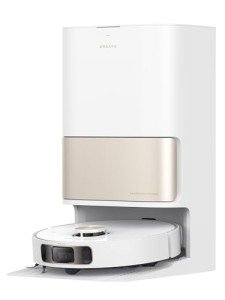Robotic Hoovers: Revolutionizing Home Cleaning
In the hectic world we live in, where time is of the essence, family chores frequently take a rear seat. Among the most significant advancements in domestic innovation are robotic hoovers, or robotic vacuum. These intelligent machines have actually changed the method people approach cleaning their homes, permitting effectiveness and benefit that traditional vacuuming can not match. This short article dives into the functions, advantages, and future of robotic hoovers, along with resolving common questions about their functionality and maintenance.
What Are Robotic Hoovers?
Robotic hoovers are automated vacuum cleaners developed to navigate through spaces and clean floors without human intervention. They make use of different innovations, including sensors, cameras, and expert system, to spot dirt and browse obstacles, making them an important addition to contemporary homes.
Key Features of Robotic Hoovers
Smart Navigation: Most robotic vacuums are geared up with advanced sensory technology that allows them to map and browse spaces efficiently. This consists of:
- Lidar Sensors: To create a map of the home.
- Infrared Sensors: To avoid barriers and drops (like stairs).
- Cliff Sensors: Prevents the unit from falling off edges.
- Automated Scheduling: Many robotic hoovers can be configured to clean up at particular times, taking full advantage of convenience for users.
- Self-Charging: Most models go back to their docking stations when their battery is low, guaranteeing they are constantly charged and all set to clean.
- App Connectivity: Modern robotic vacuums often feature apps that allow users to control their devices remotely, set schedules, and even see cleaning maps.
- Several Cleaning Modes: Options such as spot cleaning, edge cleaning, and arranged cleaning permit for tailored cleaning routines based on the family needs.
Advantages of Robotic Hoovers
- Time-Saving: Robotic hoovers can run individually, freeing up important time for house owners to concentrate on other tasks.
- Consistency: They supply constant cleaning efficiency and keep floor tidiness without the disparity that often includes manual vacuuming.
- Availability: With their compact style, robotic hoovers can quickly reach under furnishings and into tight areas where conventional vacuums battle.
- Maintenance of Various Floor Types: Many robotic vacuum cleaners can adapt to different surface areas, consisting of carpets, wood, tile, and more.
- Integration with Smart Home Systems: They can be connected to smart home devices, permitting users to integrate them into their home automation systems.
Comparison of Popular Robotic Hoovers
Here's a quick comparison of some popular models in the market:
| Model | Smart Navigation | App Connectivity | Battery Life | Price Range |
|---|---|---|---|---|
| iRobot Roomba 675 | Yes | Yes | 90 minutes | ₤ 250 - ₤ 300 |
| Neato Botvac D7 | Yes | Yes | 120 minutes | ₤ 600 - ₤ 700 |
| Eufy RoboVac 11S | Yes | Limited | 100 minutes | ₤ 200 - ₤ 250 |
| Roborock S6 | Yes | Yes | 150 minutes | ₤ 500 - ₤ 600 |
| Shark ION Robot | Yes | Yes | 120 minutes | ₤ 250 - ₤ 350 |
Upkeep and Care for Robotic Hoovers
In spite of their automated functions, robotic hoovers require regular maintenance to ensure their optimal efficiency. Here are some ideas for keeping a robotic vacuum:
- Empty the Dustbin Frequently: Regular clearing assists maintain suction power.
- Tidy the Brushes: Hair and debris can obstruct brushes; regular cleaning avoids this.
- Inspect the Filters: Dirty filters can impede efficiency; they need to be cleaned or changed as specified by the producer.
- Check Wheels and Sensors: Ensuring that the wheels are devoid of obstacles and sensing units are tidy will boost navigation and efficiency.
- Update the Firmware: Keeping the robotic vacuum's software up-to-date can solve bugs and enhance functionality.
Future of Robotic Hoovers
As technology continues to develop, the potential for improvements in robotic vacuums is vast. Innovations on the horizon might consist of:
- Improved AI Capabilities: Enhanced learning algorithms may enable robotic hoovers to much better comprehend homes and cleaning requirements.
- Combination with More Smart Home Devices: Future designs may become much more incorporated with home automation systems, improving use.
- Advanced Cleaning Features: Innovations like mopping capabilities and deeper carpet cleaning functionality could expand their energy.
- Sustainability Features: Future models may incorporate environment-friendly technologies, such as solar charging or recyclable products.
Regularly Asked Questions (FAQs)
How much do robotic hoovers generally cost?
- Rates for robotic hoovers vary considerably depending on features, however normally variety from ₤ 200 to ₤ 800.
How loud are robotic hoovers?
- A lot of robotic vacuums operate at a sound level in between 50 to 70 decibels, which is quieter than traditional vacuums.
Can robotic vacuums manage pet hair?
- Yes, many robotic hoovers are designed specifically with powerful suction and brushes to handle family pet hair efficiently.
Do robotic vacuums work on carpets?
- Definitely. best robot vacuum for large house of robotic vacuums can clean various kinds of surface areas including carpets, hardwood, and tiles.
Do I need to program my robotic vacuum?
- While you can set schedules and choices by means of an app, numerous designs can likewise run on demand or automatically once charged.
In conclusion, robotic hoovers represent an exceptional leap in home cleaning technology, using impressive benefit and effectiveness that attract modern-day property owners. As best robot vacuums continues to advance, these devices promise even much better cleaning abilities, further improving home hygiene and upkeep. For anyone seeking to streamline their cleaning routines, buying a robotic hoover can be a tremendously rewarding choice.

